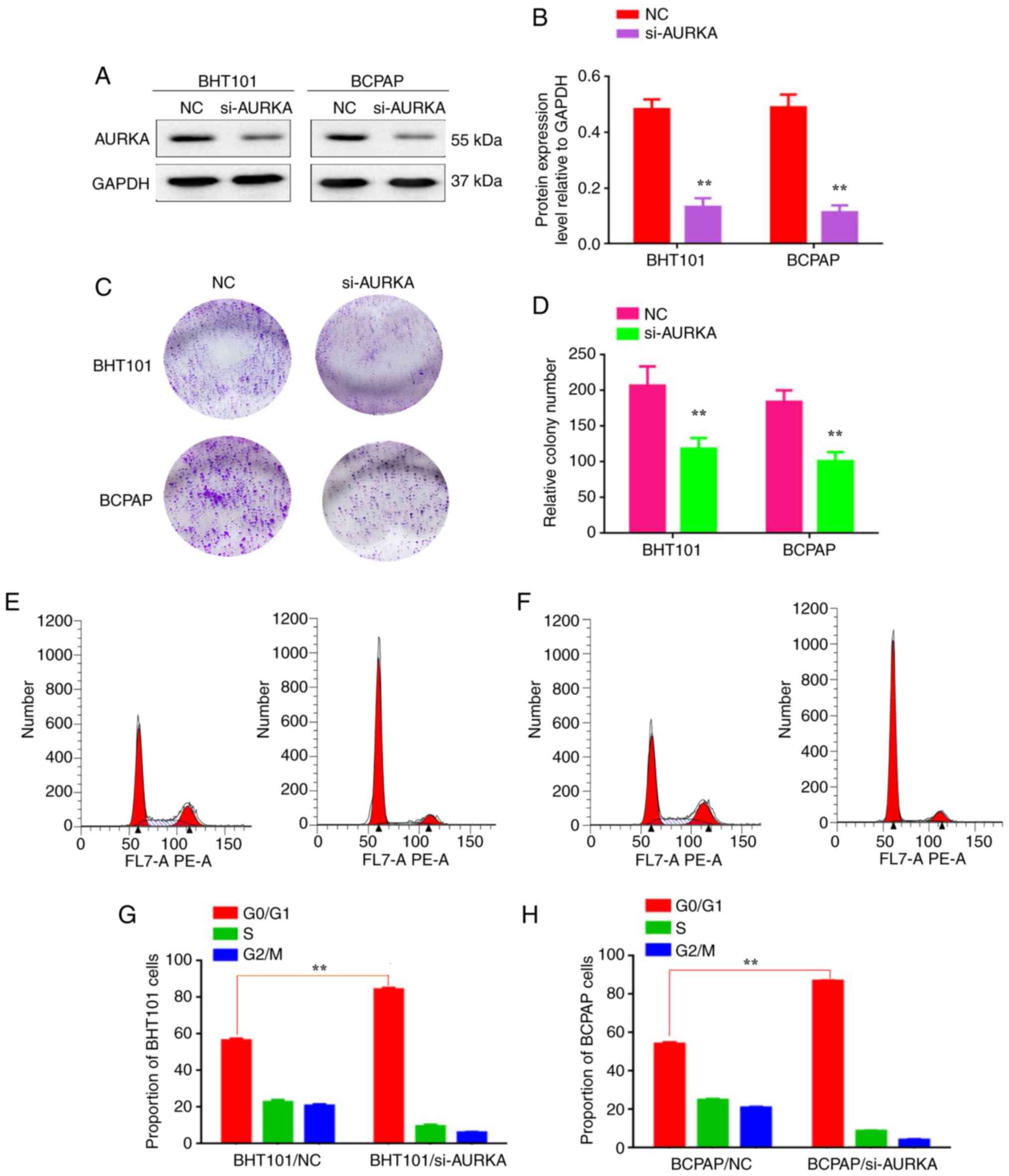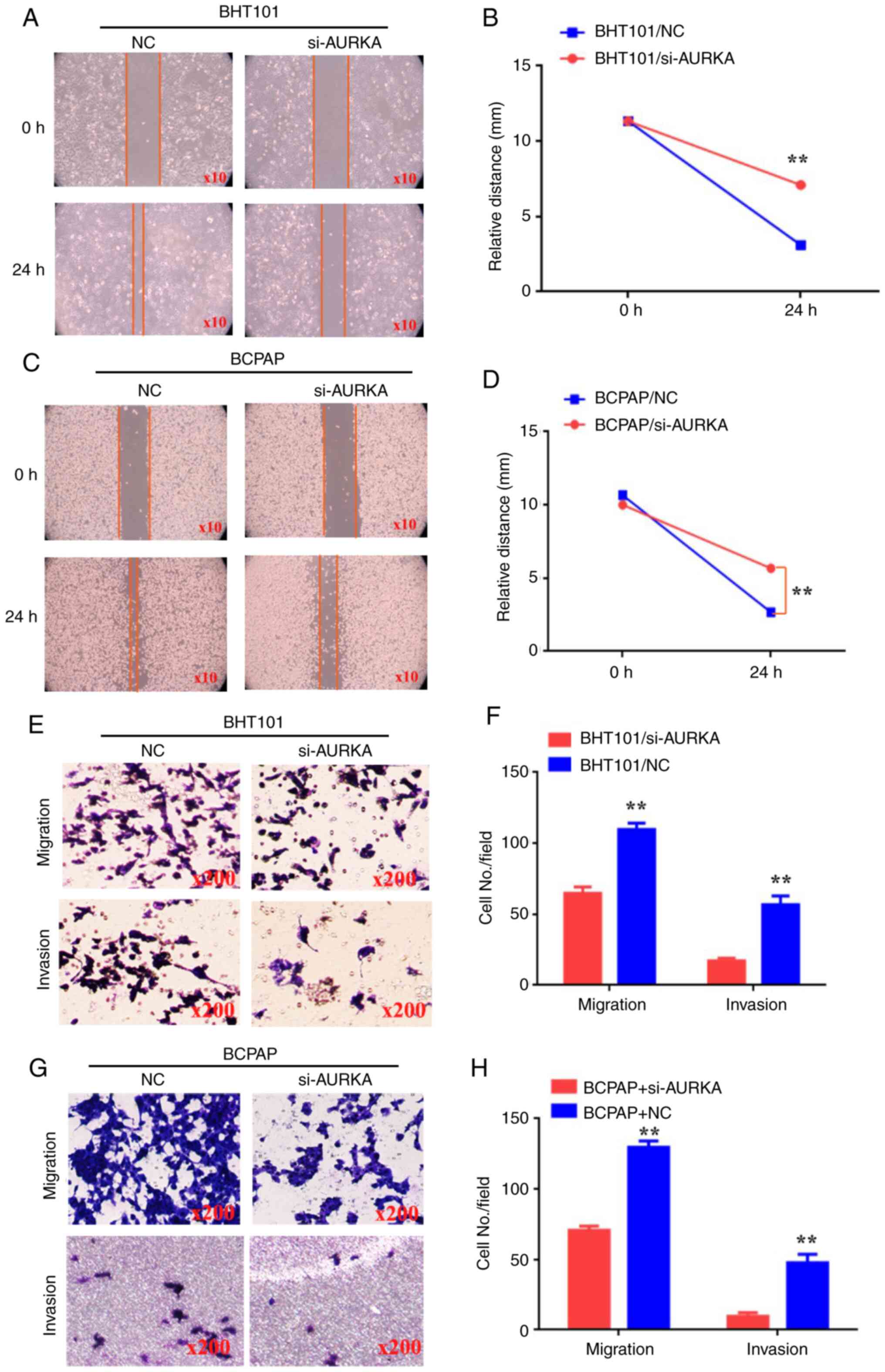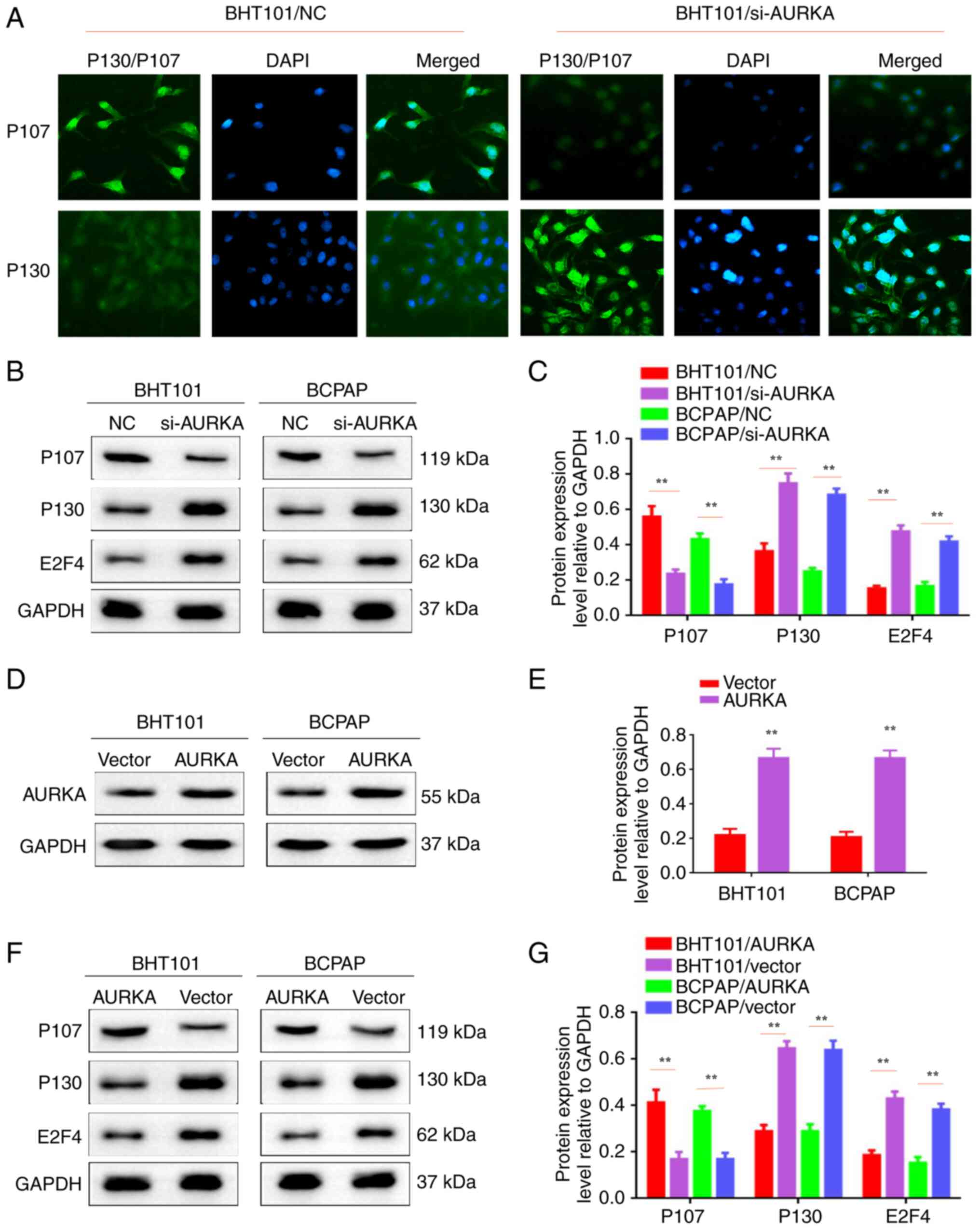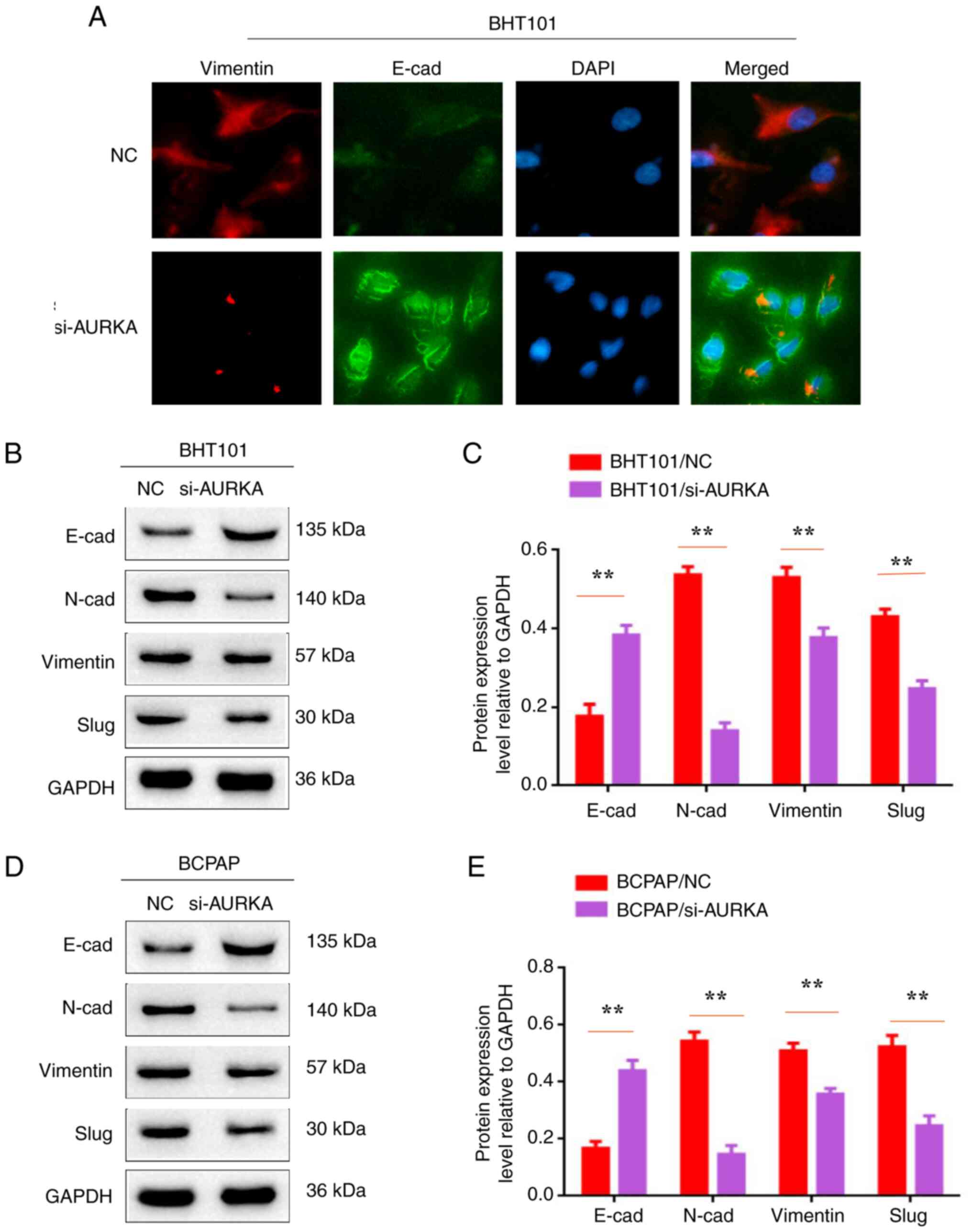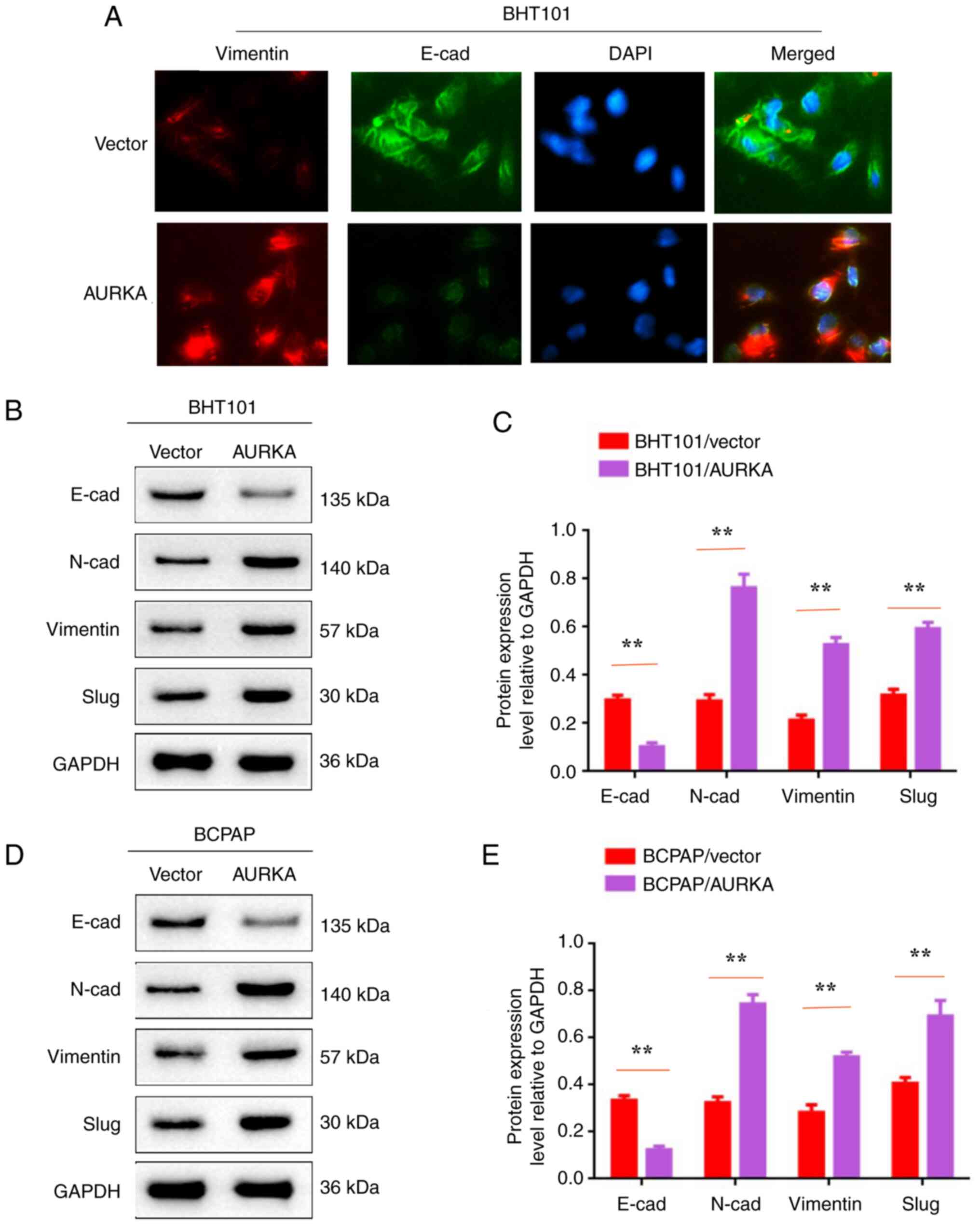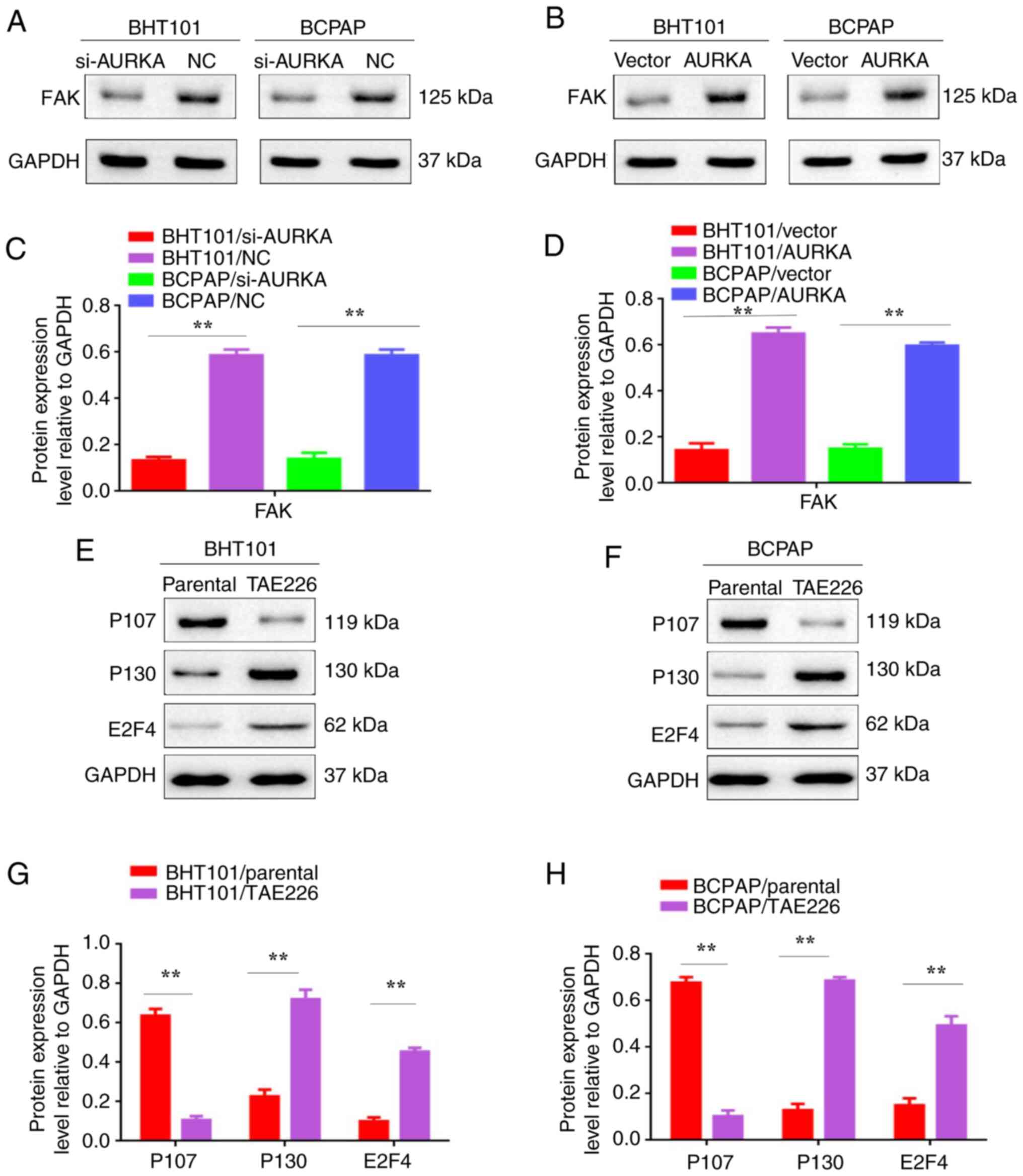Aurora kinase A promotes epithelial‑mesenchymal transition by regulating P130 and P107 molecules in thyroid cancer cells
- Authors:
- Published online on: March 12, 2025 https://doi.org/10.3892/etm.2025.12843
- Article Number: 93
-
Copyright: © Yang et al. This is an open access article distributed under the terms of Creative Commons Attribution License.
Abstract
Introduction
Thyroid cancer (THCA) ranks among the most prevalent malignancies arising from the endocrine system (1), with a rising global incidence (2). Although the five-year survival rate for patients with THCA is notably high when treated with radioiodine, mortality rates escalate significantly due to lymph node and distant metastases (3). Consequently, elucidating the specific molecular mechanisms underlying THCA metastasis is of paramount importance.
Aurora kinase A (AURKA) is a member of the Aurora family of serine/threonine kinases, involved in cell division through the formation of bipolar mitotic spindles and the maintenance of chromosomal stability (4). A previous study demonstrated that AURKA promotes lymph node metastasis in papillary THCA by enhancing cofilin-1 activity (5). In our earlier research, the authors observed that AURKA reactivates dormant laryngeal squamous cell carcinoma (LSCC) cells; however, its role in THCA remains unclear (6).
Recent evidence indicated that epithelial-mesenchymal transition (EMT) serves as a primary mechanism for cancer metastasis in breast (7), gastric (8), pancreatic (9) and colorectal cancers (10), among others. EMT is the process by which epithelial cells de-differentiate into mesenchymal-like derivatives. A previous study revealed that ISL1 targeting AURKA facilitates the development of neuroblastoma (NB), promoting EMT and metastatic processes (11). Similarly, the initiation of the EMT program in thyroid epithelial cells contributes to recurrent and metastatic diseases (12). These findings suggest a link between AURKA and EMT in the context of THCA metastasis.
Therefore, in the present study, reducing AURKA expression decreased the proliferation and inhibited the transition of BHT101 and BCPAP cells from the G0 phase to active division. Furthermore, downregulating AURKA expression enhanced the movement, migration and invasion capabilities of BHT101 and BCPAP cells. Additionally, AURKA regulates proliferation-related molecules. Specifically, the knockdown of AURKA expression increased the expression of P130 and E2F4, while reducing the expression of P107. Furthermore, upregulating AURKA expression promoted EMT, whereas downregulation of AURKA expression resulted in the opposite effect. In addition, the focal adhesion kinase (FAK) signaling pathway has been shown to play a crucial role in THCA metastasis, with inhibition of FAK hindering the movement, migration and invasion of THCA cells. Therefore, AURKA promotes EMT by regulating P130 and P107 to facilitate THCA metastasis.
Materials and methods
Cell culture
BCPAP and BHT101 cells were obtained from Shanghai Institutes of Biological Sciences (Shanghai, China) and were cultured in DMEM (YOBIBIO) supplemented with 10% fetal bovine serum (YOBIBIO). The cells were maintained in a humidified incubator at 37˚C. In the TAE226 treatment protocol, THCA cells (including BCPAP and BHT101) were treated with the FAK inhibitor TAE226 (2.1 µM/ml; Selleck Chemicals) for 24 h at 37˚C. The control groups included THCA cells treated with DMSO and THCA cells without any treatment.
Plate colony formation assay
Cells, with or without treatment, were seeded into 6-well plates at a density of 1x103 cells per well. After one month of culture, the cells were washed twice with PBS and fixed with pure methanol for 15 min at 37˚C. The cells were then stained with crystal violet for 30 min at 37˚C. Finally, colonies consisting of >50 cells in each well were manually counted.
Flow cytometry
The cells were seeded into 6-well plates and rinsed three times with cold PBS. They were then fixed with precooled anhydrous ethanol at 4˚C overnight. The fixed cells were removed from 4˚C and equilibrated at room temperature for 15 min. The samples were centrifuged at 3,162 x g for 5 min, and the supernatant was discarded. A total of 10 ml of PBS was added, and the mixture was well mixed before another centrifugation at 3,162 x g for 5 min to remove the supernatant. After adding 2 ml of PBS and mixing, the cells were transferred to a flow tube and were centrifuged at 3,162 x g for 5 min to remove the supernatant. In total, 40 µl of 50 µg/ml RNase A (Beyotime Institute of Biotechnology) was added, and the mixture was well mixed before incubation at 37˚C in the dark for 30 min with intermittent shaking. A total of 20 µl of 50 µg/ml PI staining solution (BD Pharmingen) was added, and the cells were incubated at room temperature in the dark for 15 min. Cell cycle analysis was performed by flow cytometry on a FACScan instrument (Beckman Coulter, Inc.), and analyzed using FlowJo v10 (FlowJo LLC) and GraphPad Prism software v6.0 (Dotmatics).
Immunofluorescence (IF)
Cells were seeded into Millicell EZ SLIDES (MilliporeSigma) and fixed with 4% paraformaldehyde for 30 min at 37˚C. The slides were then rinsed three times with PBS, blocked with 5% BSA for 1 h at 37˚C, and incubated overnight at 4˚C with anti-AURKA (1:100; cat. no. 66757-1-Ig; Cell Signaling Technology, Inc.), anti-P130 (1:100; cat. no. 13383; Cell Signaling Technology, Inc.) and anti-P107 (1:100; cat. no. 13354-1-AP; Proteintech Group, Inc.). The slides were incubated with Alexa Fluor® 488 goat anti-rabbit IgG (1:1,000; cat. no. 4412S; Cell Signaling Technology, Inc.) and Alexa Fluor® 555 goat anti-rabbit IgG (1:1,000; cat. no. 4413S; Cell Signaling Technology, Inc.) for 1 h at room temperature in the dark. DAPI (1:1,000; Beyotime Institute of Biotechnology) was used to stain nuclei for 5 min in the dark at 37˚C. The slides were rinsed three times with PBS and analyzed by fluorescent microscopy at x10 magnification.
siRNA interference
The day before transfection, cells were seeded into 6-well plates at a density of 5x105 cells/ml (1.5 ml per well). Transfection was performed 16 h later. For transfection, siRNA was mixed with Opti-MEM to achieve a final concentration of 100 nM, with a total volume of 250 µl, and was left at room temperature for 5 min. In a separate tube, 5 µl of Lipofectamine® 2000 (Invitrogen; Thermo Fisher Scientific, Inc.) was added to 250 µl of Opti-MEM and incubated at room temperature for 5 min. The diluted siRNA was then combined with the transfection reagent and incubated at room temperature for 20 min. Finally, 500 µl of the RNA transfection mixture was added to each well containing the cells. Subsequently, 6 h post-transfection, the culture medium was replaced with 1.5 ml of fresh complete medium. Cells were collected 48 h after transfection for western blot analysis. The sequences were as follows: si-AURKA forward, 5'-GAAGAGAGUUAUUCAUAGADTDT-3' and reverse, 5'-UCUAUGAAUAACUCUCUUCDTDT-3'); and siNC forward, 5'-UACGUACUAUCGCGCGGAUTT-3' and reverse, 5'-AUCCGCGCGATAGUACGUATT-3' were purchased from Shanghai Kaiji Company.
Construction of overexpression plasmids
The plasmid backbone used for the overexpression of AURKA was pEX-3 (pGCMV/MCS/Neo), which was purchased from Shanghai GenePharma Co., Ltd. The AURKA gene was amplified from genomic DNA extracted from BCPAP and BHT101 cells using the Qiagen DNeasy Blood & Tissue Kit (Qiagen GmbH) according to the manufacturer's instructions. PCR amplification was performed using Taq DNA polymerase (Thermo Fisher Scientific, Inc.) with the following primers: Forward (EcoRI site), 5'-CCGGAATTCGCCACCATGCATATCACCATCACTCAACTCAGTGGAGCATTCAGATAG-3' and reverse (BamHI site), 5'-CCGGGATCC TCAGTTGGAGGTATCATGAACACTG-3'. The thermocycling conditions included an initial denaturation at 95˚C for 5 min, followed by 35 cycles of denaturation at 95˚C for 30 sec, annealing at 60˚C for 30 sec and extension at 72˚C for 1 min per kb of template, with a final extension at 72˚C for 10 min. PCR products were analyzed using 1.5% agarose gel electrophoresis and visualized with SYBR Safe staining (Invitrogen; Thermo Fisher Scientific, Inc.) under UV light using a gel imaging system. The plasmid carrying the vector was extracted from overnight bacterial cultures (3-5 ml) using the QIAGEN Plasmid Mini Kit (Qiagen GmbH). The vector was then subjected to double digestion with EcoRI and BamHI (1.5 µl of each enzyme, 3 µl Green Buffer, 23 µl ddH2O and 1 µg vector) at 37˚C for 3 h. After digestion, the product was purified by 0.8% agarose gel electrophoresis followed by gel extraction using QG buffer and isopropanol precipitation. The target fragment was amplified using PCR with 10 ng template DNA, 2 µl of each primer (10 µM), 25 µl PCR mix and 21 µl double-distilled water. Following PCR, the product was recovered and digested under similar conditions as the vector. Both the vector and insert were ligated using T4 DNA Ligase (1 µl) in a reaction containing 2 µl T4 DNA ligation buffer, 70 ng vector, an equimolar amount of the insert (calculated based on vector concentration) and double-distilled water to a final volume of 20 µl at 22˚C for 60 min. The ligation mixture (10 µl) was then used to transform E. coli DH5α (EC0112; Thermo Fisher Scientific, Inc.) competent BCPAP and BHT101 cells through heat shock (90 sec at 42˚C), followed by incubation in SOC medium (cat. no. 15544034; Thermo Fisher Scientific, Inc.) for 45 min at 17 x g at 37˚C. Finally, the transformed cells were plated on selective agar plates containing the appropriate antibiotic (ampicillin; 1 µg/ml) and incubated overnight at 37˚C. Several single colonies were incubated in small quantities, which were screened and confirmed by sequencing (Sanger). The Sanger sequencing traces are shown Fig. S1.
AURKA overexpression plasmid transfection
For transfection, plasmid DNA (500 µg/µl) was diluted in Opti-MEM and transfected using Lipofectamine® 2000 (Invitrogen; Thermo Fisher Scientific, Inc.). The mixture was incubated at room temperature for 5-20 min to allow DNA-lipid complexes to form before being added dropwise onto the cells. Cells were incubated at 37˚C with 5% CO2 for 4-6 h before replacing the transfection mixture with fresh growth medium. For stable cell line selection, cells were cultured for 72 h post-transfection before adding selection medium containing 1 mg/ml G418. Selection was continued for 2 weeks until resistant colonies emerged. Once stable cell lines were established, the cells were maintained in selection medium containing 0.2 mg/ml G418 to preserve stable knockdown efficiency. The effect of overexpression was examined by western blotting. The time interval between transfection and subsequent experiments was 24-72 h.
Western blotting
The procedures for the western blotting have been previously described (6). Antibodies used included Anti-P130 (1:2,000; rabbit mAb; 13383), anti-E2F4 (1:2,000; rabbit mAb; 40291), anti-E-cad (1:2,000; mouse mAb; 14472), anti-N-cad (1:2,000; mouse mAb; 14215), anti-Vimentin (1:2,000; rabbit mAb; 5741), anti-Slug (1:2,000; rabbit mAb; 9585) and anti-GAPDH (1:2,000; rabbit; 2118T), which were all obtained from Cell Signaling Technology, Inc. Anti-P107 (1:2,000; rabbit; 13354-1-AP) and anti-AURKA (1:2,000; mouse; 66757-1-Ig) were sourced from Proteintech Group, Inc. The membranes were incubated with primary antibodies at 4˚C overnight. Proteins (40 µg/lane) were separated by 10 or 12.5% SDS-PAGE for 2 h. Following the addition of secondary antibodies (1:2,000; anti-rabbit IgG; HRP-linked antibody; 7074; anti-mouse IgG; HRP-linked antibody; 7076; Cell Signaling Technology, Inc.), the membranes were incubated with secondary antibodies at room temperature for 1 h. The membranes were visualized using Thermo Pierce chemiluminescent (ECL) Western Blotting Substrate (Thermo Fisher Scientific, Inc.) and were detected with a Tanon 5200 system (Tanon Science and Technology Co., Ltd.).
For the detection of the proteins of interest and the loading control (GAPDH), it should be noted that the proteins were not probed for on the same membranes due to the limitations of the experimental setup. Despite this, the western blots were conducted under consistent conditions to maintain the integrity of the data. A total of 40 µg of protein was loaded into each lane to ensure sample consistency across the experiments. Separate blots were performed for each target protein to avoid cross-reactivity and ensure reliable quantification.
Wound healing assay
Cells were seeded into six-well plates at a density of 1x106 cells per well and cultured until they reached confluence. The monolayer was then scratched using a 200-µl pipette tip, and the medium was replaced with fresh medium containing 1% FBS. Images of the cells were captured by fluorescence microscopy at a magnification of x10 at 0 and 24 h post-scratch. To quantify wound healing, the maximum width of the wound was measured and analyzed using GraphPad Prism software v6.0 (Dotmatics).
Migration and invasion assays
For the migration assay, 2x105 cells suspended in 200 µl of serum-free DMEM were added to the top chamber of a Transwell insert (pore size, 8 µm; Corning, Inc.). The lower chamber was filled with 600 µl of DMEM supplemented with 10% FBS. After 24 h, the cells that had migrated to the lower surface of the filter were fixed with 4% paraformaldehyde for 15 min at 37˚C and stained with 0.5% crystal violet solution for 20 min at 37˚C, and images were captured under an Olympus BX50 light microscope (Olympus Corporation) at a magnification of x10.
For the invasion assay, the top chamber membrane was first coated with Matrigel (Becton, Dickinson and Company) at 4˚C overnight. After 24 h of culture at 37˚C, tumor cells remaining on the upper side of the inserts were removed with cotton swabs. The remaining steps were identical to those of the migration assay.
Statistical analysis
All experiments were repeated at least three times and the data are presented as the mean ± SD. Significant differences between groups were determined using an unpaired Student's t-test (two groups) and one-way ANOVA (multiple groups; GraphPad Prism software v6.0; Dotmatics), and Tukey's Honestly Significant Difference test was used for post hoc comparisons. P<0.05 was considered to indicate a statistically significant difference.
Results
Decreasing AURKA expression reduces the proliferation of BHT101 and BCPAP cells
To investigate the specific regulatory mechanism by which AURKA promotes THCA metastasis, AURKA expression was silenced by transfecting AURKA-siRNA into BHT101 and BCPAP cells (designated as BHT101/AURKA-siRNA and BCPAP/AURKA-siRNA, respectively) and were compared with untreated controls (BHT101/AURKA-NC and BCPAP/AURKA-NC). The silencing effect was confirmed by results shown in Fig. 1A and B (P<0.01). The plate colony formation assay demonstrated a reduction in the number of colonies formed by BHT101/AURKA-siRNA (207±26.8) and BCPAP/AURKA-siRNA cells (184±16.2) compared with BHT101/AURKA-NC (118±14.9) and BCPAP/AURKA-NC cells (101±12.8; Fig. 1C and D; P<0.01). Flow cytometric analysis revealed that AURKA inactivation induced G2/M phase arrest in BHT101/AURKA-siRNA and BCPAP/AURKA-siRNA cells (Fig. 1E-H; P<0.01). These findings suggest that AURKA promotes proliferation by inhibiting G2/M phase arrest in BHT101 and BCPAP cells.
Decreasing AURKA expression inhibits the migration and invasion of BHT101 and BCPAP cells
To further explore the true role of AURKA in THCA metastasis, wound healing, migration and invasion assays were conducted to assess the capabilities of BHT101 and BCPAP cells. The results of the wound healing assay indicated that BHT101/AURKA-siRNA and BCPAP/AURKA-siRNA cells exhibited reduced motility at 24 h compared with BHT101/AURKA-NC and BCPAP/AURKA-NC cells (Fig. 2A-D; P<0.01). Additionally, it was observed that BHT101/AURKA-siRNA (64±2.6) and BCPAP/AURKA-siRNA cells (70±1.76) migrated less than BHT101/AURKA-NC cells (109±2.6) and BCPAP/AURKA-NC cells (129±2.6; Fig. 2E-H; P<0.01). Furthermore, BHT101/AURKA-siRNA cells (17±1.1) and BCPAP/AURKA-siRNA cells (9±1.45) invaded less than BHT101/AURKA-NC cells (56±3.5) and BCPAP/AURKA-NC cells (47±3.48; Fig. 2E-H; P<0.01). These results suggest that reducing AURKA expression inhibited the migration and invasion of BHT101 and BCPAP cells.
AURKA inhibition could reduce the proliferation by regulating P130 and P107 molecules
Our previous study indicated that P130 and P107 molecules played crucial roles in cancer cell cycle and proliferation (6). In the present study, IF staining showed that P107 and P130 were localized in the nucleus. P107 levels decreased, while P130 increased in BHT101/AURKA-siRNA and BCPAP/AURKA-siRNA cells compared with controls (BHT101/AURKA-NC cells and BCPAP/AURKA-NC cells; Fig. 3A). Similarly, western blotting showed that proliferation-related molecule (P107) expression decreased in BHT101/AURKA-siRNA and BCPAP/AURKA-siRNA cells. Proliferation-related molecules (P130 and E2F4) increased in BHT101/AURKA-siRNA and BCPAP/AURKA-siRNA cells (Fig. 3B and C; P<0.01). Furthermore, AURKA was efficiently upregulated in BHT101 and BCPAP cells (Fig. 3D and E; P<0.01). Conversely, the proliferation-related molecule (P107) increased in BHT101/AURKA and BCPAP/AURKA cells. Proliferation-related molecules (P130 and E2F4) decreased in BHT101/AURKA and BCPAP/AURKA cells (Fig. 3F and G; P<0.01). Therefore, it was concluded that AURKA inhibition reduced proliferation by regulating P130 and P107 molecules.
Inactivation of AURKA inhibits EMT in BHT101 and BCPAP cells
EMT has been recognized to play a crucial role in metastasis. In the present study, EMT-related proteins E-cadherin, N-cadherin, vimentin and slug were assessed in BHT101/AURKA-siRNA, BCPAP/AURKA-siRNA, BHT101/AURKA-NC and BCPAP/AURKA-NC cells. IF staining results showed that E-cadherin expression was higher in BHT101/AURKA-siRNA and BCPAP/AURKA-siRNA cells, while vimentin expression was lower compared with controls (BHT101/AURKA-NC and BCPAP/AURKA-NC cells). Western blot results similarly revealed increased E-cadherin levels. However, other EMT-related molecules (N-cadherin, vimentin and slug) were decreased (Fig. 4B-E; P<0.01). Thus, it was concluded that AURKA inactivation inhibits EMT in BHT101 and BCPAP cells.
Activation of AURKA promotes EMT in BHT101 and BCPAP cells
To further explore AURKA-mediated EMT in THCA metastasis, EMT-related proteins E-cadherin, N-cadherin, vimentin and slug were assessed in BHT101/AURKA, BCPAP/AURKA, BHT101/vector and BCPAP/vector cells. IF staining revealed that E-cadherin expression was decreased and vimentin expression was increased in BHT101/AURKA and BCPAP/AURKA cells compared with controls (BHT101/vector and BCPAP/vector cells; Fig. 5A). Western blot analysis demonstrated decreased E-cadherin levels and increased expression of other EMT-related molecules (N-cadherin, vimentin and slug) in AURKA-activated BHT101 and BCPAP cells (Fig. 5B-E; P<0.01). Therefore, it was concluded that AURKA activation promotes EMT in BHT101 and BCPAP cells.
AURKA promotes EMT through the FAK signaling pathway and FAK pathway inhibition impacts proliferation-related proteins
The FAK signaling pathway has been recognized to play a crucial role in cancer metastasis (13-16). To explore the importance of FAK in THCA metastasis, protein expression levels were determined using western blot analysis. FAK protein levels decreased in BHT101/si-AURKA and BCPAP/si-AURKA cells (Fig. 6A-D; P<0.01). To further demonstrate that AURKA promotes EMT by regulating P130 and P107 molecules through FAK signaling in THCA cells, P107, P130 and E2F4 expression levels were explored in THCA cells treated with the FAK inhibitor TAE226(17). Western blot results revealed that P130 and E2F4 were increased and P107 decreased in BHT101/TAE226 and BCPAP/TAE226 cells (Fig. 6E-H, P<0.01). These findings indicate that AURKA promotes EMT by regulating P130 and P107 molecules through the FAK signaling pathway in THCA cells.
Blocking FAK impairs the movement, migration and invasion of THCA cells
To further investigate the potential of inhibiting the tumor-promoting effects of THCA by blocking FAK expression, wound-healing, migration and invasion assays were used to examine the movement, migration and invasion abilities of THCA cells. THCA cells were treated with the FAK inhibitor TAE226 (BCPAP/TAE226 and BHT101/TAE226 cells). Control groups included THCA cells treated with DMSO (BCPAP/parental and BHT101/parental cells) and THCA cells without any treatment (BCPAP/ctrl and BHT101/ctrl cells). In the wound-healing assay, BCPAP/TAE226 and BHT101/TAE226 cells demonstrated reduced motility at 24 h compared with BCPAP/parental and BHT101/parental cells (Fig. 7A-D; P<0.01). Moreover, the migration assay results demonstrated that BCPAP/TAE226 (102±6.8) and BHT101/TAE226 (101±5.23) cells showed decreased movement through Matrigel compared with BCPAP/parental (250±9.64), BCPAP/ctrl (248±13.96), BHT101/parental (251±14.34) and BHT101/ctrl cells (252±17.61; Fig. 7E and F; P<0.01). For the invasion assay, the results identified that BCPAP/TAE226 (29±3.48) and BHT101/TAE226 (26±3.18) cells exhibited decreased movement through Matrigel compared with BCPAP/parental (103±3.48), BCPAP/ctrl (102±9.20), BHT101/parental (103±9.33) and BHT101/ctrl cells (109±6.93; Fig. 7G and H; P<0.01). These findings indicated that blocking FAK impairs the movement, migration and invasion of THCA cells.
Discussion
THCA is a malignancy originating from thyroid epithelial cells, characterized by a high incidence rate. Metastasis remains the leading cause of mortality among patients with THCA (18). However, the precise molecular and cellular mechanisms governing THCA metastasis are still not fully understood. Clarifying these mechanisms is critical for identifying potential molecular targets aimed at improving patient survival rates and quality of life.
Years following initial treatment, patients with THCA might experience the development of local remnants or disseminated tumors. This phenomenon can be attributed to tumor dormancy-a phase where residual disease exists but remains asymptomatic. The reactivation of dormant tumor cells could lead to recurrence and metastasis. Therefore, exploring the specific molecular mechanisms behind the activation of THCA dormancy holds significant theoretical and practical value.
Building upon findings of previous studies that highlighted the pivotal role of AURKA in LSCC tumorigenesis and metastasis both in vitro (19) and in vivo (20), the authors examined the impact of AURKA on cell proliferation, cell cycle progression and mobility in LSCC cell lines. AURKA, an evolutionarily conserved Aurora serine/threonine kinase, regulates the cell cycle (21) through processes such as centrosome maturation, mitotic entry, centrosome separation, bipolar spindle assembly, chromosome alignment, cytokinesis and mitotic exit (22). Disruption during mitosis can result in genetic instability and tumorigenesis. Colony formation and flow cytometry assays demonstrated that AURKA promoted proliferation, whereas the downregulation of AURKA inhibited the transition from the G0 phase to active division in BHT101 and BCPAP cells. Increased AURKA expression also enhanced movement, migration and invasion capabilities in BHT101 and BCPAP cells.
Research increasingly indicates that the proliferation-associated proteins P130 and E2F4 are abundant in quiescent cells (23,24), while P107 proteins are less prevalent (25). E2F4, an E2F transcription factor, mediates the expression of cell cycle proteins (26). In the present study, the inhibition of AURKA reduced proliferation by regulating P130 and P107 molecules.
There is increasing evidence suggesting that EMT plays a role in tumor invasion and metastasis (27). During tumor metastasis, cancer cells acquire a mesenchymal phenotype and increased invasiveness through EMT, allowing them to penetrate surrounding tissues. At implantation sites, cancer cells eventually form metastases that resemble the primary tumor through EMT (28), which is closely linked to tumor biological characteristics and involves multiple regulatory mechanisms. As research advances, various mechanisms have been identified, including those involved in tumor growth, evasion and dissemination, which hold significant clinical implications and may provide new approaches for diagnosing and treating tumor metastasis.
However, the molecular basis and regulatory mechanisms of THCA EMT remain largely unexplored, presenting a major challenge for research. In the present study, the relationship between AURKA and EMT was explored in the context of THCA metastasis. To the best of the authors' knowledge, no prior studies have examined this aspect within THCA. Additionally, upregulated AURKA expression promoted EMT, whereas downregulated AURKA expression inhibited EMT.
While the present study provided valuable insights, several limitations should be acknowledged. Primarily, the research focuses on in vitro cell models without conducting in vivo experiments to validate the observed phenomena, limiting the applicability of the findings to clinical settings. Additionally, the relatively small sample size may impact the generalizability and statistical power of the results. The use of a single or limited number of cell lines might not fully capture the variability between different cell types. Long-term effects and complex molecular mechanisms were also not thoroughly investigated, and the techniques employed each have inherent limitations. Future studies should aim to address these constraints to provide more comprehensive and accurate information.
In conclusion, based on the aforementioned findings, it was demonstrated that AURKA promotes EMT by regulating P130 and P107 genes, thereby facilitating the metastasis of THCA. Consequently, AURKA may represent a viable therapeutic target in the treatment of THCA.
Supplementary Material
Verification of cloned colonies by Sanger sequencing. Screening and confirmation were conducted using Sanger sequencing to verify that the sequence of the inserted fragment in the recombinant clones was completely consistent with the target fragment sequence. AURKA, Aurora kinase A; CMV, cytomegalovirus; PEX, plasmid vector.
Acknowledgements
Not applicable.
Funding
Funding: The present study was supported by the Shanghai Healthy Youth Project (grant no. 20234Y0055), the Natural Science Foundation of Fujian (grant no. 2023J011342), Pudong the New Area Clinical Characteristic Discipline (grant no. PWYts2021-15), the Subject Construction Project of Pudong Health Commission of Shanghai (grant no. PWZy2020-06), the Gongli Hospital National Fund Cultivation Project (grant no. 2022GPY-B04), the Key Specialty Construction Project of Health Bureau of Shanghai (grant no. ZX2019C06) and the Pudong New Area Clinical Characteristic Discipline (grant no. PWYts2021-15).
Availability of data and materials
The data generated in the present study may be requested from the corresponding author.
Authors' contributions
LY and YG performed the experiments. LY and JL analyzed the data. LY wrote the manuscript. GW revised the manuscript. LY and GW designed the study. LY and GW interpreted the data. LY and GW confirm the authenticity of all the raw data. All authors read and approved the final version of the manuscript.
Ethics approval and consent to participate
Not applicable.
Patient consent for publication
Not applicable.
Competing interests
The authors declare that they have no competing interests.
References
|
Liao Y, Hua Y, Li Y, Zhang C, Yu W, Guo P, Zou K, Li W, Sun Y, Wang R, et al: CRSP8 promotes thyroid cancer progression by antagonizing IKKα-induced cell differentiation. Cell Death Differ. 28:1347–1363. 2021.PubMed/NCBI View Article : Google Scholar | |
|
Xu S, Mo S, Lin J, Yan Y, Liu X, Wu K, Zhang H, Zhu Y, Chen L and Chen X: Loss of ID3 drives papillary thyroid cancer metastasis by targeting E47-mediated epithelial to mesenchymal transition. Cell Death Discov. 7(226)2021.PubMed/NCBI View Article : Google Scholar | |
|
Zhan S, Wang T and Li J, Zhu H, Ge W and Li J: Asporin interacts with HER2 to promote thyroid cancer metastasis via the MAPK/EMT signaling pathway. Front Oncol. 12(762180)2022.PubMed/NCBI View Article : Google Scholar | |
|
Asteriti IA, Polverino F, Stagni V, Sterbini V, Ascanelli C, Naso FD, Mastrangelo A, Rosa A, Paiardini A, Lindon C and Guarguaglini G: AurkA nuclear localization is promoted by TPX2 and counteracted by protein degradation. Life Sci Alliance. 6(e202201726)2023.PubMed/NCBI View Article : Google Scholar | |
|
Maimaiti Y, Jie T, Jing Z, Changwen W, Pan Y, Chen C and Tao H: Aurora kinase A induces papillary thyroid cancer lymph node metastasis by promoting cofilin-1 activity. Biochem Biophys Res Commun. 473:212–218. 2016.PubMed/NCBI View Article : Google Scholar | |
|
Yang LY, He CY, Chen XH, Su LP, Liu BY and Zhang H: Aurora kinase A revives dormant laryngeal squamous cell carcinoma cells via FAK/PI3K/Akt pathway activation. Oncotarget. 7:48346–48359. 2016.PubMed/NCBI View Article : Google Scholar | |
|
Ban Y, Zou Y, Liu Y, Lee SB, Bednarczyk RB, Sheng J, Cao Y, Wong STC and Gao D: Targeting ribosome biogenesis as a novel therapeutic approach to overcome EMT-related chemoresistance in breast cancer bioRxiv. Preprint. 28(546927)2023.PubMed/NCBI View Article : Google Scholar | |
|
Zhang Z, Li Y, Fan L, Wang B, Liu W, Cui J and Tan B: LncRNA THUMPD3-AS1 promotes invasion and EMT in gastric cancer by regulating the miR-1297/BCAT1 pathway. iScience. 26(108012)2023.PubMed/NCBI View Article : Google Scholar | |
|
Meng F, Hua S, Chen X, Meng N and Lan T: Lymph node metastasis related gene BICC1 promotes tumor progression by promoting EMT and immune infiltration in pancreatic cancer. BMC Med Genomics. 16(263)2023.PubMed/NCBI View Article : Google Scholar | |
|
Koyama Y, Fujihara S, Chiyo T, Matsui T, Hamaya S, Fujita K, Tani J, Morishita A, Kobara H, Ono M, et al: Role of Mir-452-5p overexpression in epithelial-mesenchymal transition (EMT) in early-stage colorectal cancer. In Vivo. 37:1980–1990. 2023.PubMed/NCBI View Article : Google Scholar | |
|
Li M, Sun C, Bu X, Que Y, Zhang L, Zhang Y, Zhang L, Lu S, Huang J, Zhu J, et al: ISL1 promoted tumorigenesis and EMT via Aurora kinase A-induced activation of PI3K/AKT signaling pathway in neuroblastoma. Cell Death Dis. 12(620)2021.PubMed/NCBI View Article : Google Scholar | |
|
Miro C, Di Cicco E, Ambrosio R, Mancino G, Di Girolamo D, Cicatiello AG, Sagliocchi S, Nappi A, De Stefano MA, Luongo C, et al: Thyroid hormone induces progression and invasiveness of squamous cell carcinomas by promoting a ZEB-1/E-cadherin switch. Nat Commun. 10(5410)2019.PubMed/NCBI View Article : Google Scholar | |
|
Jiang W, Cai F, Xu H, Lu Y, Chen J, Liu J, Cao N, Zhang X, Chen X, Huang Q, et al: Extracellular signal regulated kinase 5 promotes cell migration, invasion and lung metastasis in a FAK-dependent manner. Protein Cell. 11:825–845. 2020.PubMed/NCBI View Article : Google Scholar | |
|
Li H, Fu X, Zhao J, Li C, Li L, Xia P, Guo J, Wei W, Zeng R, Wu J, et al: EXOC4 promotes diffuse-type gastric cancer metastasis via activating FAK signal. Mol Cancer Res. 20:1021–1034. 2022.PubMed/NCBI View Article : Google Scholar | |
|
He X, Wang L, Li H, Liu Y, Tong C, Xie C, Yan X, Luo D and Xiong X: CSF2 upregulates CXCL3 expression in adipocytes to promote metastasis of breast cancer via the FAK signaling pathway. J Mol Cell Biol. 15(mjad025)2023.PubMed/NCBI View Article : Google Scholar | |
|
Liu P, Sun Y, Liu S, Niu J, Liu X and Chu Q: SY-707, an ALK/FAK/IGF1R inhibitor, suppresses growth and metastasis of breast cancer cells. Acta Biochim Biophys Sin (Shanghai). 54:252–260. 2022.PubMed/NCBI View Article : Google Scholar | |
|
Ghosh S and Cho SJ: Three-dimensional-QSAR and relative binding affinity estimation of focal adhesion kinase inhibitors. Molecules. 28(1464)2023.PubMed/NCBI View Article : Google Scholar | |
|
Xiao Y, Tu Y and Li Y: Expression level of long non-coding RNA colon adenocarcinoma hypermethylated serves as a novel prognostic biomarker in patients with thyroid carcinoma. Biosci Rep. 41(20210284)2021.PubMed/NCBI View Article : Google Scholar | |
|
Zhang H, Chen X, Jin Y, Liu B and Zhou L: Overexpression of Aurora-A promotes laryngeal cancer progression by enhancing invasive ability and chromosomal instability. Eur Arch Otorhinolaryngol. 269:607–614. 2012.PubMed/NCBI View Article : Google Scholar | |
|
Zhang H, Chen X, Liu B and Zhou L: Effects of stable knockdown of Aurora kinase A on proliferation, migration, chromosomal instability, and expression of focal adhesion kinase and matrix metalloproteinase-2 in HEp-2 cells. Mol Cell Biochem. 357:95–106. 2011.PubMed/NCBI View Article : Google Scholar | |
|
Niu NK, Wang ZL, Pan ST, Ding HQ, Au GH, He ZX, Zhou ZW, Xiao G, Yang YX, Zhang X, et al: Pro-apoptotic and pro-autophagic effects of the Aurora kinase A inhibitor alisertib (MLN8237) on human osteosarcoma U-2 OS and MG-63 cells through the activation of mitochondria-mediated pathway and inhibition of p38 MAPK/PI3K/Akt/mTOR signaling pathway. Drug Des Devel Ther. 9:1555–1584. 2015.PubMed/NCBI View Article : Google Scholar | |
|
Dar AA, Goff LW, Majid S, Berlin J and El-Rifai W: Aurora kinase inhibitors - rising stars in cancer therapeutics? Mol Cancer Ther. 9:268–278. 2010.PubMed/NCBI View Article : Google Scholar | |
|
Correa RJ, Peart T, Valdes YR, DiMattia GE and Shepherd TG: Modulation of AKT activity is associated with reversible dormancy in ascites-derived epithelial ovarian cancer spheroids. Carcinogenesis. 33:49–58. 2012.PubMed/NCBI View Article : Google Scholar | |
|
Ruppender N, Larson S, Lakely B, Kollath L, Brown L, Coleman I, Coleman R, Nguyen H, Nelson PS, Corey E, et al: Cellular adhesion promotes prostate cancer cells escape from dormancy. PLoS One. 10(130565)2015.PubMed/NCBI View Article : Google Scholar | |
|
Spiliotaki M, Mavroudis D, Kapranou K, Markomanolaki H, Kallergi G, Koinis F, Kalbakis K, Georgoulias V and Agelaki S: Evaluation of proliferation and apoptosis markers in circulating tumor cells of women with early breast cancer who are candidates for tumor dormancy. Breast Cancer Res. 16(485)2014.PubMed/NCBI View Article : Google Scholar | |
|
Iyirhiaro GO, Zhang Y, Estey C, O'Hare MJ, Safarpour F, Parsanejad M, Wang S, Abdel-Messih E, Callaghan SM, During MJ, et al: Regulation of ischemic neuronal death by E2F4-p130 protein complexes. J Biol Chem. 289(18202)2014.PubMed/NCBI View Article : Google Scholar | |
|
Huang Y, Hong W and Wei X: The molecular mechanisms and therapeutic strategies of EMT in tumor progression and metastasis. J Hematol Oncol. 15(129)2022.PubMed/NCBI View Article : Google Scholar | |
|
Subbalakshmi AR, Sahoo S, McMullen I, Saxena AN, Venugopal SK, Somarelli JA and Jolly MK: KLF4 induces mesenchymal-epithelial transition (MET) by suppressing multiple emt-inducing transcription factors. Cancers (Basel). 13(5135)2021.PubMed/NCBI View Article : Google Scholar |



